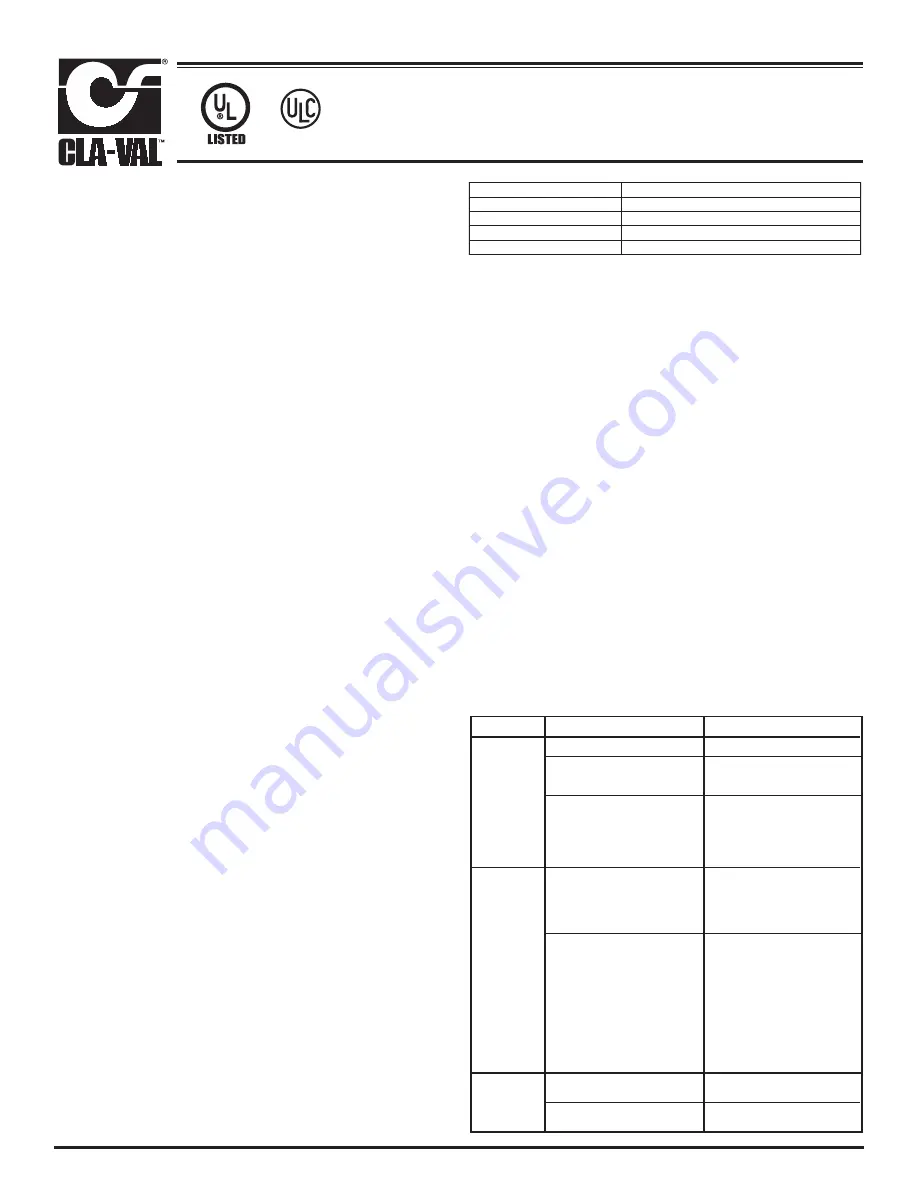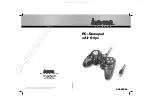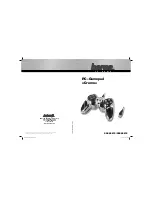
UL Listed Pilot-Operated Pressure Control
INSTALLATION / OPERATION / MAINTENANCE
90G-21/90A-21 UL
MODEL
The Cla-Val 90-21 Pressure Reducing Valve is a pilot-operated regulator,
capable of holding downstream pressure to a predetermined pressure.
1.
SPECIAL NOTE:
For system protection, on valve sizes 1-1/2" thru 8" a
UL Listed minimum 1/2" pressure relief valve shall be installed down-
stream (system side) of the 90-21 Pressure Reducing Valve. For valve
sizes 10" and 12" a UL Listed 3" or larger relief valve shall be installed
downstream side of the 90-21. Adequate drainage of the relief valve dis-
charge must be provided. The relief valve should be set above the “no
flow” or “dead end” shutoff pressure which is at 2 to 8 psi higher than the
90-21 set pressure for 1-1/2" thru 8" valve sizes and 2 psi for 10" and 12"
valve sizes.
2. Allow sufficient room around the valve assembly to make adjustments
and for disassembly.
3. It is recommended that isolation valves be installed on both ends of the
90-21 valve to facilitate isolating the valve for start-up, testing and preven-
tative maintenance.
4.
BEFORE THE VALVE IS INSTALLED, PIPE LINES SHOULD BE
FLUSHED OF ALL CHIPS, SCALE, AND FOREIGN MATTER.
5. Place the 90-21 valve in line with flow through the valve in the direction
indicated on the nameplate. Check all fittings and hardware for proper
makeup and that no apparent damage is evident.
6. Cla-Val valves operate with maximum efficiency when mounted in hori-
zontal piping with the cover UP; however, other positions are acceptable.
Due to size and weight of cover and internal components of six inch and
larger valves, installation with the cover up is advisable. This makes peri-
odic inspection of internal parts readily accessible.
7. Installation, testing, inspection and maintenance shall be in accordance
with NFPA 13, 14 and 25.
Start-Up and Adjustment
1. Upon initial start-up and after any valve servicing, it is necessary to fol-
low these steps.
2. Prior to pressurizing the valve make sure the necessary gauges to
measure pressure are installed. Gauges should be installed upstream
(inlet) and downstream (outlet) of the valve. Unused ports on main valve
body can be used for this purpose.
CAUTION:
During start-up and test procedures a large volume of water
may be discharged downstream. Check to make sure that the downstream
venting is adequate to prevent damage to personnel and equipment.
3. Close upstream and downstream isolation valves.
4. Slowly open the upstream isolation valve enough to allow the valve and
pilot control system to fill with liquid.
5. Bleed air from the main valve (1) cover and pilot system by slightly loos-
ening fittings or plugs at all high points until a steady flow of water is
observed retighten. It may be necessary to do this more than once.
6. Open fully the upstream isolation valve.
7. Slowly open the downstream isolation valve part way to establish a low
flow rate.
There must be liquid flowing through the valve during pressure
adjustments
.
Optimum valve performance occurs when pressure setting is done with
flow rate as low as practical.
8. Adjust the CRD Control (3) to desired pressure. To change pressure setting,
turn the adjusting screw in (clockwise) to increase outlet pressure. Turn the
adjusting screw out (counterclockwise) to decrease outlet pressure. The pres-
sure should change approximately 27 psi per turn. Only slight changes in
adjustment should be made to avoid damage to equipment. When the
desired setting has been made, tighten jam nut and replace cover.
9. To fine tune the operation of the main valve, an oscillation control device
is included but may not be necessary. Adjust screw clockwise/counter-
clockwise until system pressures stabilize.
10. For 1-1/2" thru 8" 90-21 Pressure Reducing Valves the downstream
pressure relief control recommended set point is 2-8 psi above the CRD
(3) set point. For 10" and 12" 90-21 Pressure Reducing Valves the set
point is 2 psi above the CRD (3) set point. The relief valve for the 10" and
12" 90-21 shall be installed a recommended minimum 6 pipe diameters
downstream of the 90-21
11. Pressure ratings of components installed downstream of the Model 90-21
pilot operated pressure control valve shall not be exceeded.
12. Valves shall be tested after installation in accordance with NFPA 13 or
NFPA 14 or both NFPA 13 and 14, whichever is applicable, and tested peri-
odically thereafter in accordance with NFPA 25.
Maintenance
1. The Cla-Val 90-21 Pressure Reducing Valve requires no lubrication or
packing and a minimum of maintenance. However, a periodic inspection
schedule should be established to determine how the fluid handled is
affecting the efficiency of the valve. Minimum of once per year.
2. When servicing the pilot control system, use care to prevent damage. If
it is necessary to remove fittings or components, be sure they are kept
clean and replaced exactly as they were.
3. Repair and maintenance procedures of the Cla-Val Hytrol Main Valve
and pilot control components are included in a more detailed IOM manual.
It can be downloaded from our web site (www.cla-val.com) or obtained by
contacting a Cla-Val Regional Sales Office.
4.
When ordering parts always refer to the catalog number and stock
number on the valve nameplate.
Main valve
fails to open
Main valve
fails to close
Fails to
Regulate
No pressure at valve inlet
Main valve diaphragm assembly
inoperative
Pilot Valve (CRD) not opening:
1. No. spring compression
2. Damaged spring
3. Spring guide not in place
4. Yoke dragging on inlet nozzle
Foreign matter between disc
and seat or worn disc. Scale on
stem or Diaphragm ruptured
Flow Clean Strainer plugged
Pilot Valve (CRD) remain open:
1. Spring compressed solid
2. Mechanical obstruction
3. Worn disc
4. Yoke dragging on inlet nozzle
5. Diaphragm damaged or loose
diaphragm nut. Leakage from
vent hole in cover
Air in main valve cover and/or
tubing
Pilot Valve (CRD) yoke dragging
on inlet nozzle
Check inlet pressure
Disassemble, clean and polish
stem, replace detective parts
1. Tighten adjusting screw
2. Disassemble and replace
3. Assemble properly.
4. Assemble properly
Disassemble main valve,
remove matter, clean parts and
replace defective parts
Remove and clean or replace
1. Back off adjusting screw
2. Disassemble and remove
obstruction
3. Disassemble remove and
replace disc retainer assembly
4. Assemble properly
5. Disassemble. replace
diaphragm and/or tighten nut
Loosen top cover plug and fit-
tings and bleed air
Assemble properly
SYMPTOM
PROBABLE CAUSE
REMEDY
LISTED
Valve Size
Minimum Differential Pressure
1-1/2"
20 psid
2" - 8"
10 psid
10"
20 psid
12"
45 psid




















